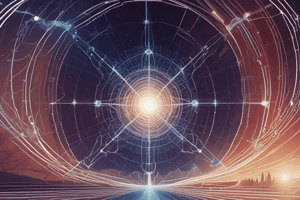Podcast
Questions and Answers
What is the frequency in sec$^{-1}$ for light with a wavelength of 325 nm?
What is the frequency in sec$^{-1}$ for light with a wavelength of 325 nm?
- 3.10 x 10$^{16}$
- 1.31 x 10$^{15}$ (correct)
- 9.23 x 10$^{14}$
- 4.80 x 10$^{12}$
What is the energy in Joules of a photon with a wavelength of 1.0 nm?
What is the energy in Joules of a photon with a wavelength of 1.0 nm?
- 1.24 x 10$^{-14}$
- 2.00 x 10$^{-15}$
- 1.97 x 10$^{-18}$
- 6.63 x 10$^{-16}$ (correct)
Which subshell corresponds to the quantum number l = 2?
Which subshell corresponds to the quantum number l = 2?
- s
- d (correct)
- p
- f
Which group of atoms is most likely to acquire an additional electron based on electron affinity trends?
Which group of atoms is most likely to acquire an additional electron based on electron affinity trends?
Which of the following sets of quantum numbers is valid?
Which of the following sets of quantum numbers is valid?
How many possible orientations (ml values) are permitted for l = 2?
How many possible orientations (ml values) are permitted for l = 2?
How many electrons can occupy the subshell described by the quantum numbers n = 2, l = 0?
How many electrons can occupy the subshell described by the quantum numbers n = 2, l = 0?
Which theory states that the mass and exact position of an electron cannot be determined simultaneously?
Which theory states that the mass and exact position of an electron cannot be determined simultaneously?
Flashcards
Frequency of 325 nm UV light
Frequency of 325 nm UV light
The number of wave cycles passing a point per second, calculated using the speed of light (c) and the wavelength (λ) with the formula: ν = c/λ
Frequency of 489 nm light
Frequency of 489 nm light
Frequency (Hz) is the number of waves passing a given point per second, calculated as speed of light divided by the wavelength.
Energy of 1.0 nm photon
Energy of 1.0 nm photon
The energy (J) of a photon is calculated by multiplying Planck's constant (h), the speed of light (c) and dividing by the wavelength (λ) with the formula: E = hc/λ
Energy of 453 nm photon (Joules)
Energy of 453 nm photon (Joules)
Signup and view all the flashcards
Subshell for l=2
Subshell for l=2
Signup and view all the flashcards
Valid quantum numbers (n, l, ml, ms)
Valid quantum numbers (n, l, ml, ms)
Signup and view all the flashcards
Electron affinity trend
Electron affinity trend
Signup and view all the flashcards
Heisenberg's Uncertainty Principle
Heisenberg's Uncertainty Principle
Signup and view all the flashcards
Study Notes
Electromagnetic Radiation and Quantum Numbers
-
Wavelength and Frequency (Problem 1): UV light's wavelength is 325 nm. Find the frequency.
-
Laser Light Frequency (Problem 2): An argon ion laser emits light at 489 nm. Calculate its frequency.
-
Photon Energy (Problems 3 & 4): Calculate the energy of a photon with a 1.0 nm wavelength and a 453 nm wavelength photon. Include units (Joules).
-
Quantum Number (Problem 5): If an electron has a quantum number (l) of 2, which subshell is it in?
-
Correct Quantum Number Set (Problem 6): Identify the single correct set of quantum numbers (n, l, ml, ms) from the choices provided.
Atomic Structure and Trends
-
Modern Quantum Theory (Problem 8): The modern quantum theory states that the electron's exact position and mass cannot be determined simultaneously—only probability of location is possible.
-
Orbital Orientations (Problem 9): Determine the allowed ml values for l = 2.
-
Electrons in Subshell (Problem 10): Calculate the maximum number of electrons in a subshell with n = 2, l = 0.
-
Electron Affinity (Problem 7): Halogens are most likely to acquire an additional electron based on electron affinity trends.
Studying That Suits You
Use AI to generate personalized quizzes and flashcards to suit your learning preferences.
Related Documents
Description
This quiz covers fundamental concepts in electromagnetic radiation and quantum numbers. You will solve problems related to wavelength, frequency, photon energy, and quantum number identification. Perfect for students studying atomic structure and quantum theory.




